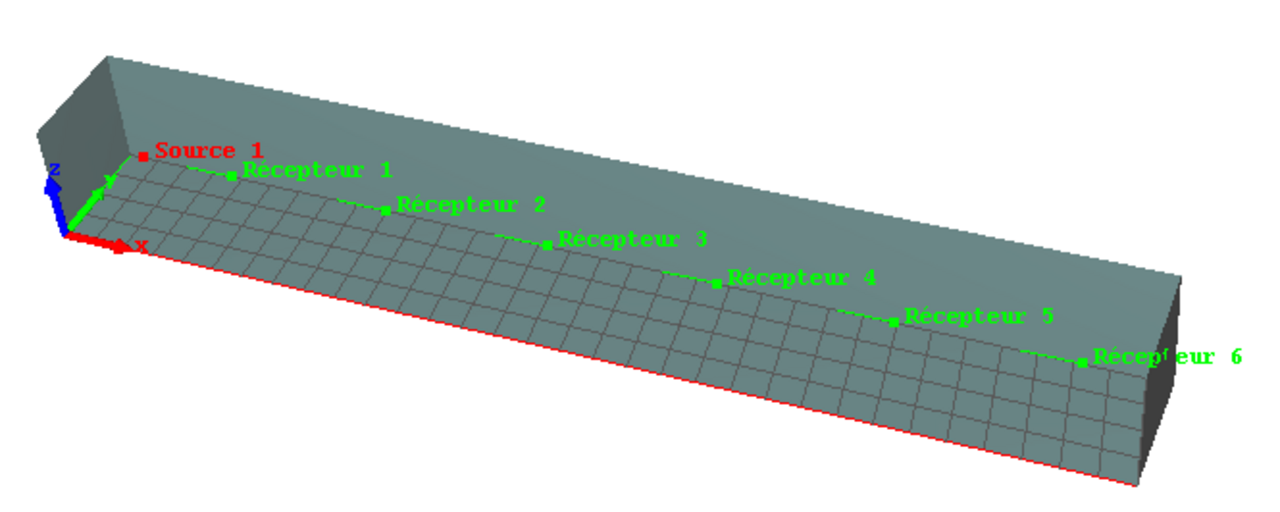All elements of this simulation are licensed under Licence Creative Commons Attribution 4.0 International License.
Long room with diffuse reflection and uniform absorption
Description
Academic case: Long room (32m x 4m x 4m) with 100% diffuse reflection and 10% uniform surface absorption, with a single source at (2,2,2) and a line of 6 punctual receivers at locations (2,5:5:30,2).
What is tested?
Comparison between I-Simpa simulations (TCR, SPPS, MD) using the geometry described in [Valeau, 2006] and an external code (RAYSCAT). This allows to compare numerical results in a geometry that is not in agreement with the assumptions of a diffuse sound field.
[Valeau, 2006] Valeau, V., Picaut, J., Hodgson, M. , "On the use of a diffusion equation for room-acoustic prediction", J. Acoust. Soc. Am. 119, 1504 (2006). doi.org/10.1121/1.2161433
CAUTION - The following results present comparisons between numerical simulations carried out with I-Simpa and 'reference' data available in the scientific literature.
- It is difficult to prejudge the concept of 'reference'. The deviation between the simulations and the reference data that can be observed do not necessarily call into question the corresponding simulations but can also be associated with other sources of deviation (modeling assumptions, numerical instabilities, experimental uncertainties, etc.).
- Note also that these comparaisons can also show the limitations of some numerical codes.
Results
In terms of sound level (total field), the SPPS and MD codes gives similar results, showing a decrease of sound levels along the room. As expected for such configuration (i.e. not in the assumptions of a diffuse field), the TCR code, far for the source (i.e. outside the direct field), the sound field remains quite constant that is not observed in practice. This problem concerning the TCR code, is also shown for the RT30 and EDT results.
Both for the EDT and the RT30 results, the SPPS and MD codes gives very similar behavior than those using the external code RAYSCAT (see [Valeau, 2006]). One can however observe larger deviations for the EDT between the MD codes and the SPPS/RAYSCAT codes that may du to the lack of modelling of the first reflections with the diffusion model, while the early reflection contributions are important for the calculation of the EDT. Despite this particular point, this result shows the ability of the diffusion model (MD code) for evaluating the sound field in long spaces.
Reference (copie 1)
| Parameters | Value |
|---|---|
| Active calculation of Atmospheric absorption | NO |
| Active calculation of diffusion by fitting objects | NO |
| Active calculation of direct field only | NO |
| Active calculation of transmission | NO |
| Calculation method | Energetic |
| Limit value of the particle extinction | 5.0 |
| Number of sound particles per source | 1 000 000 |
| Number of sound particles per source (display) | |
| Random initialization number | |
| Receiver radius | 0.31 |
| Simulation length (s) | 2.000 |
| Time step (s) | 0.01 |
Reference (copie 2)
| Parameters | Value |
|---|---|
| Active calculation of Atmospheric absorption | NO |
Reference (copie 3)
| Parameters (MD_Octave) | Value |
|---|---|
| Active calculation of Atmospheric absorption | NO |
| Merge with direct field | YES |
| Diffusion equation resolution - Maximum number of iterations | 200 |
| Diffusion equation resolution - Tolerance | 0.000001 |
| Simulation length (s) | 2.000 |
| Time step (s) | 0.001 |
| Parameters (MD_Comsol) | Value |
| Active calculation of Atmospheric absorption | NO |
| Merge with direct field | YES |
| Simulation length (s) | 2.000 |
| Time step (s) | 0.01 |
What is tested?
Comparison between I-Simpa simulations (TCR, SPPS, MD) using the geometry described in [Valeau, 2006] and an external code (RAYSCAT). This allows to compare numerical results in a geometry that is not in agreement with the assumptions of a diffuse sound field.
[Veleau, 2006] Valeau, V., Picaut, J., Hodgson, M. , "On the use of a diffusion equation for room-acoustic prediction", J. Acoust. Soc. Am. 119, 1504 (2006). doi.org/10.1121/1.2161433
Description
Academic case: Long room (32m x 4m x 4m) with 100% diffuse reflection and 10% uniform surface absorption, with a single source at (2,2,2) and a line of 6 punctual receivers at locations (2,5:5:30,2).
All elements of this simulation are licensed under Licence Creative Commons Attribution 4.0 International License.


